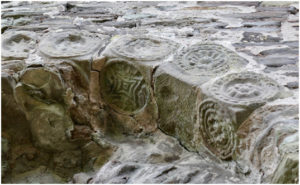The Background
Many writers on castles hold that the round stone keep was a later development in Britain, rarely occurring before the 13th century. However, there are so few castles with any definitive date that all generalisations are open to question. Even where there is sound dating evidence, it is often unclear whether it refers to a stone building or an earlier timber phase. Round stone keeps were certainly built in France during the first half of the 12th century and there is no obvious reason why the Normans would have built any differently in England and Wales. We should expect round stone keeps to have been built as soon as the rapidly-erected wooden towers needed to be replaced, especially on circular mottes.
The first reasonably well-dated round keep in Britain is at New Buckenham in Norfolk, built around 1145. It is a rather strange structure made entirely out of flint and its shape may well have been determined by a lack of good building stone.
In Britain, most round keeps are found in South Wales, mainly in the regions around Brecon and Pembroke1. Bronllys Castle near Brecon has a good example of an early round stone keep on a motte. Gerald of Wales described how, during a fire in 1175, a stone fell from the tower and killed Mahel of Hereford, which strongly suggests that the round keep had already been built by then. One of the finest round keeps is at Pembroke Castle, begun by William Marshall after 1189. With its five storeys and a domed stone roof, it hardly suggests an early example of the genre and demonstrates how round keeps had evolved by the end of the 12th century.
Elsewhere, more technically sophisticated versions of round keeps buttressed by turrets are found at Orford in Suffolk (polygonal outside but round inside), built between 1165 and 1173, and Conisbrough in Yorkshire, probably built around 1178.
Dating Longtown
It has often been stated, though with little evidence, that Longtown was rebuilt in stone around 1220 by Walter, the last of the de Lacy dynasty. Walter was Sheriff of Hereford at the time and heavily in debt. It seems highly unlikely that he would have welcomed the expense of building a new castle. When the Longtown Castles Project began, a re-assessment of the date of Longtown’s stone castle was long overdue.
Every castle is different and most have had multiple building phases, which makes dating them stylistically extremely difficult. However a careful examination of the masonry at Longtown provides some useful clues.
Longtown’s keep lacks any arrowslits, which are a normal feature of 13th century castles. Instead, the main room has three wide windows that are all the same in form, size and structure (apart from the decoration in the north window). There is nothing to support the RCHME’s suggestion that they were altered in the 14th century2. The wide embrasures have segmental arches of pitched stone that could not be inserted without first demolishing all of the stonework above them.
 The dressed stone voussoirs on the exterior are relieving arches that divert weight from the stone lintels. These too could not be inserted without risking the integrity of the stonework above them and are therefore part of the original build.
The dressed stone voussoirs on the exterior are relieving arches that divert weight from the stone lintels. These too could not be inserted without risking the integrity of the stonework above them and are therefore part of the original build.
There has been much discussion about the peculiar decorated stones over the north window. They are the work of the Herefordshire School of Romanesque Sculpture, active in the second quarter of the 12th century3. Their work is normally found in ecclesiastical buildings, not in castles. It has to be asked why these ornate stones are hidden at the back of the keep where they cannot be seen from anywhere within the bailey. Since most of them are decorated on the lower surface, which is concealed on a relieving arch, we can be sure that they were not carved for their present location.
 A close scrutiny reveals that about a third of the central stone is missing while the second stone from the right was never finished. Its lower surface is plain but flawed. This suggests that although the stones were intended for a high status project, they were rejected, until a less-critical use was found for them at Longtown.
A close scrutiny reveals that about a third of the central stone is missing while the second stone from the right was never finished. Its lower surface is plain but flawed. This suggests that although the stones were intended for a high status project, they were rejected, until a less-critical use was found for them at Longtown.
An inspection of the breach reveals some apparently re-used dressed stones within the body of the wall, which might suggest that the castle was rebuilt using stone from an earlier structure4. However, these stones appear to have been mortared in place during Ministry of Works/DoE stabilisation measures and derive from the present building. Our conclusion is that the stone keep at Longtown had only a single phase of building and that was around the middle of the 12th century.
Circumstantial evidence for a mid 12th century date for the keep at Longtown is provided by the Templar chapel at Ludlow castle, also held by the de Lacys. Around 1148, towards the end of the civil war known as the Anarchy, Gilbert de Lacy regained Ludlow. He soon became a Knight Templar and joined the Crusades around 1158. Before leaving for Palestine, he built the chapel at Ludlow in the form of a round keep, complete with crenellations and bearing a remarkable resemblance to the keep at Longtown.

Further support for a mid 12th century date came from the 2017 excavation on Castle Green. A massive deposit of clay and rubble, devoid of any habitational debris, was found to be overlain by deposits containing 12th century pottery5 . This was interpreted as being the material derived from reducing the height of the motte in order to increase the diameter of the top and provide a stable base for the new stone tower.
Conclusion
The Romanesque decorated stones and the parallel with the Ludlow chapel, supported by the archaeological evidence, point to Gilbert de Lacy having begun rebuilding Longtown castle in stone around 1150. If it was not finished by the time he went on Crusade it may have been completed by his sons Robert and Hugh de Lacy.
- Renn, D. (1961), ‘The round keeps of the Brecon region’, Archaeologia Cambrensis.
- Royal Commission on Historical Monuments, England (1931), An Inventory of the Historical Monuments in Herefordshire, Vol. 1 – South-West, HMSO, London, page 183.
- Thurlby, M. (2013), The Herefordshire School of Romanesque Sculpture, Logaston Press, Almeley, Herefordshire.
- Remfry, P.M., (1997), Longtown Castle 1048 to 1241, SCS Publishing, Gwynedd, page 36.
- Herefordshire Archaeology Report 375. see also Summary of Excavations (Castle Green Trench 3)
